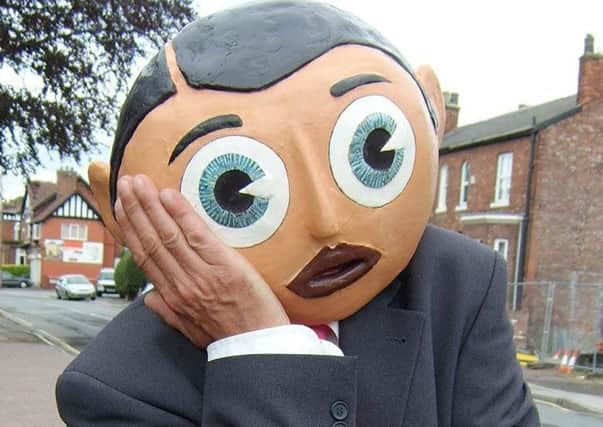Film reviews: Being Frank | At Eternity’s Gate | Dumbo | Us | Out of Blue| The Vanishing


Being Frank: The Chris Sievey Story (15) ****
At Eternity’s Gate (12A) ***
Dumbo (PG) ***
Us (15) ***
Out of Blue (15) **
The Vanishing (15) ***
Watching the new documentary Being Frank: The Chris Sievey Story, it makes sense that the titular performer behind cult entertainer Frank Sidebottom – a mainstay of the alternative comedy scene in the late 80s and early 90s– would choose a giant papier-mâché head for his alter ego: Sievey’s anarchic brain was fizzing with so many ideas that his own head clearly had no hope of containing them. That’s the never-quite-stated thesis of Steve Sullivan’s wonderful trawl through the late artist’s extensive career. Unlike the Michael Fassbender-starring Frank, which used Sidebottom as a jumping off-point for a funny, poignant, fictional exploration of the connection between artistic genius and mental illness, the new film isn’t all that interested in rehashing that debate. Instead it constructs a portrait of someone who couldn’t have lived an ordinary life if he’d tried. And he did try. He was married, had kids, worked factory jobs – but with access to the vast audio and video archives that Sievey kept of his tireless efforts to make it as a legitimate pop star, we get to see how a relentlessly creative mind can thrive, even in a place as seemingly banal as his hometown of Timperley. It’s not always a flattering portrait. Nor is it glamorous. And yet it’s precisely this unvarnished look at a way of life that continues to be mythologised and romanticised that gives the film added power.
Artistic genius and mental illness are very much at the heart of At Eternity’s Gate, Julian Schnabel’s biopic of Vincent van Gogh, which focuses on his tragic final years as he painted furiously in the South of France while incurring the suspicion and wrath of locals who didn’t understand the way his brain forced him to live. Perhaps because it’s directed by an acclaimed artist in his own right, the film doesn’t make the mistake of the recent animated biopic Loving Vincent, which painstakingly replicated the style of van Gogh’s work to little dramatic purpose. Instead Schnabel, appropriately enough, takes more of a post-impressionistic, verging on expressionistic, approach by casting Willem Dafoe and refusing to constrain his performance with the sort of rigorous fidelity to period details biopics sometimes spend too long obsessing over. Dafoe’s Vincent speaks American-accented French and English with countless linguistic anachronisms and, during moments of artistic reverie, we get blearily jaundiced point-of-view shots to give us an inkling of how he saw colour and detail and how that shaped what ended up on the canvas. It doesn’t all work, but rather this sort of film than the dreary paint-by-numbers ones we usually get.
Advertisement
Hide AdAdvertisement
Hide AdThe first of this year’s live-action Disney remakes, Dumbo benefits from director Tim Burton’s willingness to expand the outsider themes inherent in this tale of a big-eared baby elephant who discovers he can fly. Burton regular Michael Keaton takes on chief villain duties as an over-leveraged populist with fake hair who’s determined to exploit the cute little pachyderm as the star attraction of his new amusement park. Colin Farrell, meanwhile, stars as a First World War-injured circus performer whose children become obsessed with reuniting Dumbo with his targeted-for-extermination mother. All of which sounds pretty bleak, but Burton is a dab hand at couching his phantasmagorical predilections in imaginative family entertainment and this soars whenever Dumbo’s in the air.
Us wasn’t screened in time to feature in last week’s column, so it’s a little frustrating not to have the space to explore the myriad ideas (and flaws) of Jordan Peele’s follow-up to his box-office conquering, Oscar-winning debut Get Out. Another high-concept horror film, this time revolving Lupito Nyong’o and Winston Duke’s middle class family as they find themselves being terrorised by their doppelgängers, the film starts off creepily enough with an immaculately shot 1986-set prologue that plants any number of promising narrative seeds. Frustratingly, though, these fail to take root as the film jumps between smart political satire, goofy genre parody and wigged-out apocalyptic horror. Which isn’t to say there’s not evidence of brilliance here: Peele has remarkable command of his visuals, there are some smart jokes dotted throughout, and the ideas he’s exploring – the dangers of moral absolutism, the complacency of comfort, the fear of others – are timely and thought-provoking. It’s just that the way he teases them out often feels garbled, requiring big expositional info dumps that ultimately reveal a concept riddled with plot holes. In dual roles, however, Nyong’o does some remarkable work – and Elisabeth Moss has a juicy supporting turn as her soused neighbour.
Out of Blue also features a great central performance from its lead, but not even Patricia Clarkson as an alcoholic homicide cop investigating the death of an astrophysicist can sustain Carol Morley’s drearily cosmic spin on Martin Amis’s 1997 novel Night Train. There’s a black hole where the hardboiled plot should be.
The biggest surprise in The Vanishing is the rare but welcome sight of Gerard Butler being good in a half-decent film. As one of three Scottish lighthouse keepers faced with a moral dilemma when a body and a case full of gold wash up on their remote outpost, Butler digs deep to get beyond the gruff action-man machismo that’s become his default setting in recent years. Peter Mullan and newcomer Connor Swindells co-star while Danish filmmaker Kristoffer Nyholm (TV’s The Killing) directs with chilly efficiency. ■